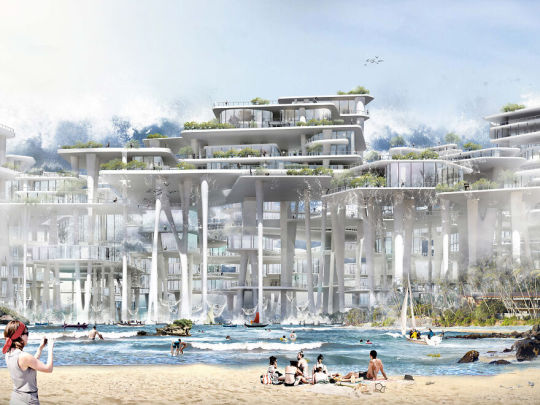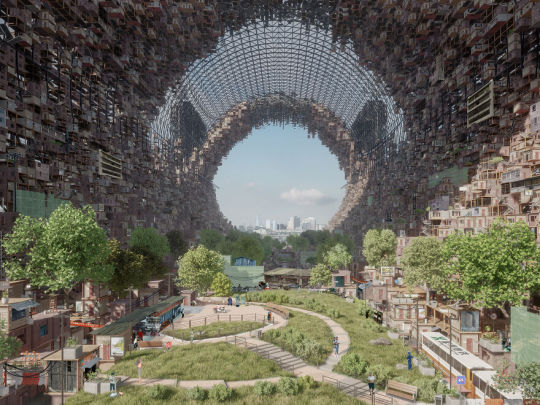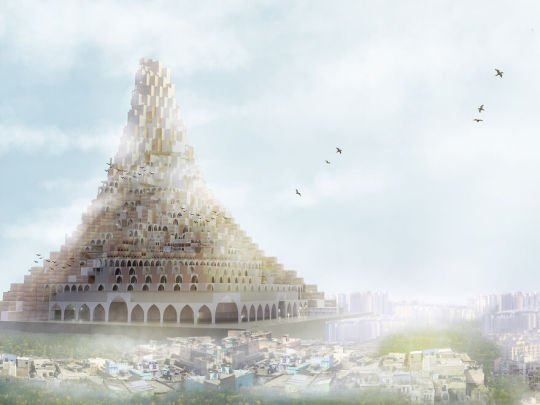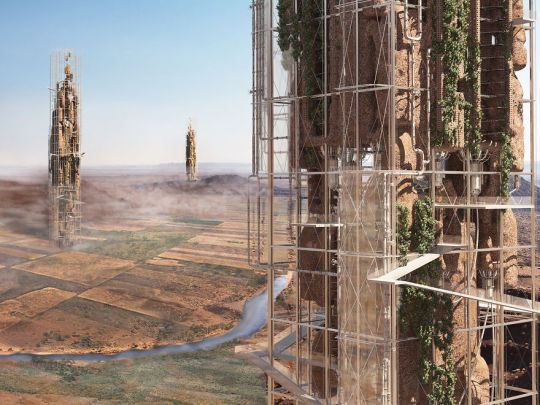#evolo magazine skyscraper competition
Explore tagged Tumblr posts
Photo
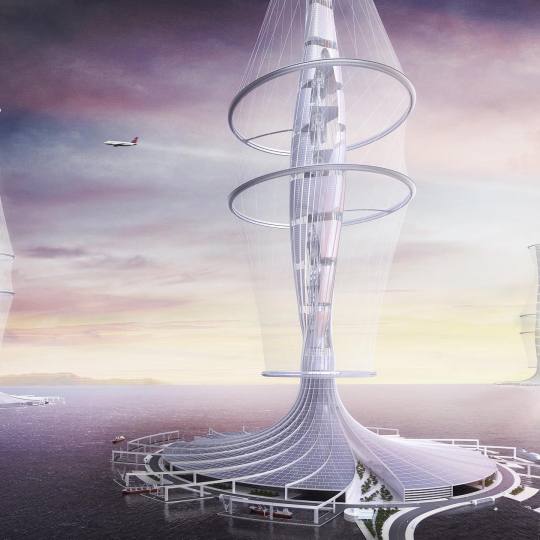
Climate Control Skyscraper.
First Place – 2022 Skyscraper Competition. Kim Gyeong Jeung, Min Yeong Gi, Yu Sang Gu.
The 2021-2022 EVolo Magazine Skyscraper Competition
#kim gyeong jeung#min yeong gi#yu sang gu#architects#future architecture#architecture#evolo magazine skyscraper competition#climate control skyscraper#building
9 notes
·
View notes
Text
Water Building Resort-Transforming air into water / Orlando de Urrutia - eVolo | Architecture Magazine
We need water buildings in LA!
If Marines were at sea we wouldn't have terrorism for a dead Queen in California.
If USA assumed Canada would it stop monarchs hollocaust? Those floppy water baloon planes didn't cut it. We haven't seen kids since @elonmuskquotes.bsky.social surrogates seized families. @elonmuskfanslounge @elonmuskdaily @cybertruck @elonenthusiast @teslamotorsblog
0 notes
Text
Skyscrapers of the future: Prestigious competition winning designs
Skyscrapers of the future: Prestigious competition winning designs
How do you imagine the skyscrapers of the future? The future moves in the rhythm of sustainability, low energy consumption and ecology. eVolo Magazine has announced the best skyscraper designs for the 2022 Skyscraper Competition. The well-known American architecture magazine eVolo has been organizing this competition since 2006. Three winners and 20 honorable mentions, as selected by the jury…

View On WordPress
0 notes
Text
Winners 2021 Skyscraper Competition
Winners 2021 Skyscraper Competition
eVolo Magazine is pleased to announce the winners of the 2021 Skyscraper Competition. The Jury selected 3 winners and 20 honorable mentions from 492 projects received. The annual award established in 2006 recognizes visionary ideas that through the novel use of technology, materials, programs, aesthetics, and spatial organizations, challenge the way we understand vertical architecture and its…

View On WordPress
0 notes
Photo
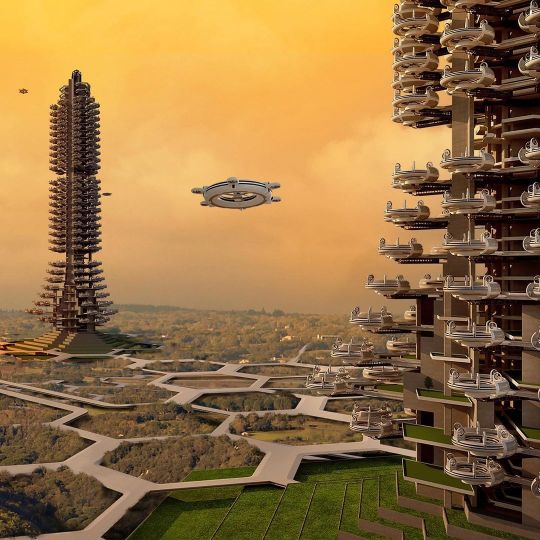
Flying Unit Nest Skyscraper.
Honorable Mention – 2022 Skyscraper Competition. Mohammad Pirdavari
The 2021-2022 EVolo Magazine Skyscraper Competition
#mohammad pirdavari#architect#architecture#future architecture#building#evolo magazine skyscraper competition#flying unit nest skyscraper
2 notes
·
View notes
Text
eVolo 2021 Skyscraper Competition Winners
2021 Skyscraper Competition Winner, eVolo Tower Design Contest News, LA Magazine, High Rise Buildings
eVolo 2021 Skyscraper Competition
May 8, 2021
The 2021 Skyscraper Competition results – internatioanl tower design contest organized by eVolo Magazine, USA.
For the 2021 edition, eVolo Magazine received 492 projects from around the world. The Jury selected 3 winners and 20 honorable mentions.
eVolo 2021 Skyscraper Competition Winners
1st prize
The first place was awarded to LIVING SKYSCRAPER designed by Andrii Lesiuk, Mykhaylo Kohut, Sofiia Shkoliar, Kateryna Ivashchuk, Nazarii Duda, Mariia Shkolnyk, Oksana-Daryna Kytsiuk, and Andrii Honcharenko from Ukraine. The project investigates the use of genetically modified trees to shape them into living skyscrapers that offer green habitable spaces to cities.
2nd prize:
The recipients of the second place are Amit Deutch, Roni Dominitz, and Tamar Kerber from Israel for the project LLUVIOSO SKYSCRAPER. This novel high-rise gathers rainwater to refill Mexico City’s groundwater supply.
3rd prize:
HMONG SKYSCRAPER designed by Xiangshu Kong, Xiaoyong Zhang, and Mingsong Sun from China received the third place. The proposal envisions a sky frame that allows traditional Hmong houses to plug in. The skyscraper grows vertically and horizontally with the addition of urban spaces.
The honorable mentions are a collection of projects that use modern technologies and materials to offer new high-rise solutions. Some of these proposals include urban parasitic systems, vertical urban fabrics, and plug-in cities among other novel designs.
The Jury was formed by Koray Duman (Principal, Büro Koray Duman), Reza Najafian (Principal, ReNa Design), Arto Ollila (Partner, Aarti Ollila Ristola), Eric Parry (Principal, Eric Parry Architects), and Isa Ye (Founder, designverse. Founder, Young Bird Plan).
Link to all winning entries: https://www.evolo.us/category/2021/
Aug 3, 2020
eVolo 2021 Skyscraper Competition Open Call
2021 Skyscraper Competition
eVolo Magazine is pleased to invite architects, students, engineers, designers, and artists from around the globe to take part in the 2021 Skyscraper Competition. Established in 2006, the annual Skyscraper Competition is one of the world’s most prestigious awards for high-rise architecture.
It recognizes outstanding ideas that redefine skyscraper design through the implementation of novel technologies, materials, programs, aesthetics, and spatial organizations; along with studies on globalization, flexibility, adaptability, and the digital revolution. It is a forum that examines the relationship between the skyscraper and the natural world, the skyscraper and the community, and the skyscraper and the city.
The participants should take into consideration the advances in technology, the exploration of sustainable systems, and the establishment of new urban and architectural methods to solve economic, social, and cultural problems of the contemporary city including the scarcity of natural resources and infrastructure and the exponential increase of inhabitants, pollution, economic division, and unplanned urban sprawl.
The competition is an investigation of the public and private space and the role of the individual and the collective in the creation of a dynamic and adaptive vertical community. It is also a response to the exploration and adaptation of new habitats and territories based on a dynamic equilibrium between man and nature – a new kind of responsive and adaptive design capable of intelligent growth through the self-regulation of its own systems.
There are no restrictions in regards to site, program, or size. The objective is to provide maximum freedom to the participants to engage the project without constraints in the most creative way. What is a skyscraper in the 21st century? What are the historical, contextual, social, urban, and environmental responsibilities of these mega-structures?
eVolo Magazine is committed to continuing stimulating the imagination of designers around the world – thinkers that initiate a new architectural discourse of economic, environmental, intellectual, and perceptual responsibility that could ultimately modify what we understand as a contemporary skyscraper, its impact on urban planning and on the improvement of our way of life.
SCHEDULE
July 15, 2020 – Competition announcement and registration opens.
November 17, 2020 – Early registration deadline
January 26, 2021 – Late registration deadline
February 9, 2021 – Project submission deadline (23:59 hours US Eastern Time)
April 27, 2021 – Winners’ announcement
JURY
Erkko Aarti [Partner, Aarti Ollila Ristola] Koray Duman [Principal, Büro Koray Duman] Reza Najafian [Principal, ReNa Design] Arto Ollila [Partner, Aarti Ollila Ristola] Eric Parry [Principal, Eric Parry Architects] Mikki Ristola [Partner, Aarti Ollila Ristola]
AWARDS
1st place – $5000 USD 2nd place – $2000 USD 3rd place – $1000 USD
Winners, honorable mentions, and selected projects will be published in the forthcoming book EVOLO SKYSCRAPERS 4 to be released in 2021.
WEBSITE
http://www.evolo.us/registration-2021-skyscraper-competition/
2021 eVolo Skyscraper Competition image / information received Aug 2020
Skyscraper Competition
World Skyscrapers on e-architect
2020 Design Contest Evolo Skyscraper Competition 2020
2019 Design Contest Evolo Skyscraper Competition 2019
2018 Design Contest Evolo Skyscraper Competition 2018
2017 Design Contest Evolo Skyscraper Competition 2017
eVolo Skyscraper Competition 2016 Winner Evolo Skyscraper Competition 2016
Winner in this design contest from 2015 Evolo Skyscraper Competition 2015
Winner in this design contest from 2014 Evolo Design Competition 2014 + Evolo Competition 2014 Winners
Winner in this design contest from 2013 Evolo Design Contest 2013
Winner in this design contest from 2012 Evolo Contest 2012
Winner in this design contest from 2011 Evolo Contest 2011
Tower Designs – international high-rise building designs
Skyscraper Buildings – best tower architecture from around the globe
Building Competitions : international design contest archive
Comments / photos for the eVolo 2021 Skyscraper Competition Prize News page welcome
Website: www.evolo.us/competition
The post eVolo 2021 Skyscraper Competition Winners appeared first on e-architect.
0 notes
Text
As Disasters Mount, Our Cities May Need to Move Underground
Temperatures are rising, and urban centers are packed. To preserve livable societies, some argue we should build ‘Earthscrapers.’
In just a few years, Mexico City will be the most crowded city in North America, perhaps in the Western Hemisphere. With 22 million people, it’s one of the fastest growing populations in the world. There are few tall buildings. Zoning restrictions abound. And it is quickly running out of land on which to expand. Geographic boundaries block it in. This is a metropolis bordered by mountains and volcanoes — the Sierra Nevadas to the east; and lower sierras and ranges to the north, west, and south. For millennia, hordes of people have been drawn to this area because of its wealth of natural resources — pine forests and rivers, wildlife, and even saltwater lakes. There is food and water aplenty. But now there is no more room to grow.
Tokyo, with 38 million residents, is the most populated metro area in the world. It has grown upward, with skyscrapers, and outward without the impediments of hard natural boundaries. Similarly, New York City has jumped the East River and morphed into Brooklyn and Queens and beyond. For Mexico City, there is no such luck. And Mexico City is on track to add millions more people by mid-century. Goldman Sachs says it may become the world’s fifth-largest economy by then. Still, historic preservationists ban renovations. Zoning laws won’t allow developers to build anything taller than five stories in the city’s core. Transportation infrastructure is aged, and the surrounding mountains inhibit connections to satellite towns that could serve as commuter alternatives. The result is mass urban concentration.
Walk through any megacity these days and the crowds are sometimes difficult to fathom. Which is why standing alone in the middle of Mexico City, in the center of its main square — Plaza de la Constitución, or the Zócalo, as it is commonly called — is so surreal. The plaza stretches nearly 800 feet in each direction and is cordoned by national monuments. Yet, there are only a few dozen people at a time crossing it. It is a vast, open area, just a lone flagpole rising high in its center. Mere steps away, outside of this main square, the city is packed, jam-packed with people and vehicles and public transportation congestion.
With as many as 10 million more people poised to be added this century to the already overstressed urban matrix, and with space limitations, the question is, where will everyone go? In all likelihood, down, underground. And they won’t be alone. All around the world, people live underground, entire cities even.
In Coober Pedy, Australia, it’s so hot that people who moved there 100 years ago to prospect for opal realized they had to build their city beneath the surface of the Earth, where it’s markedly cooler. Now close to 2,000 people live there. Coober Pedy’s average annual temperature eclipses 85 degrees Fahrenheit and during summer remains above 90 degrees and often more than 100 degrees for weeks on end. Underground, at depths of more than 30 feet, temperatures remain relatively constant and cooler. Fun fact: The average local year-round surface temperature is what you will find at these depths, no matter where you are on Earth. In Coober Pedy, that can mean a swing of 20 degrees — a big cool-off.
In primitive times, caves did the trick for providing cooler environments and protection from the elements. In modern clusters of civilization, living underground seems like an extraordinary step. That is until you consider this: Global temperatures could spike so much over the next 100 years that it will be nearly impossible for billions of people to remain living aboveground; half of the land area of the planet may become uninhabitable.
A hothouse scenario such as this would mean temperatures rising about threefold more than expected — a lot, for sure, but not outside the limit of possibility. According to a study by researchers at Purdue University and the University of New South Wales in Australia, regions too hot to survive if temperatures rise threefold would include most of the East Coast of the United States, all of India, most areas in Australia, and heavily populated parts of China.
With heat and population concentration in mind (people in affected areas would in all likelihood move to cooler geography, congesting those regions), one solution may be underground living. Besides Coober Pedy, there are major subterranean developments already in the works. In Fukuoka, Japan, architects from the Taisei Corporation of Tokyo have plans for Alice Cities — airy underground spaces connected by subway trains and subterranean roads. In Helsinki, Finland, there is a “shadow city” with a public swimming pool, shopping areas, a church, hockey arena, and an industrial center. In China, old war bunkers have been taken over by people in Beijing. In Singapore, there are plans for an underground “science city” where more than 4,000 people will live. Toronto already has its PATH system: pedestrian walkways that span for nearly 20 miles and connect transportation hubs to restaurants, shops, and other commercial spots. New York is even considering a Lowline park: It is billed as the world’s first underground park. It will use new solar technology to transform a trolley terminal into green space. Breakthroughs in lighting, mood, and spatial aesthetics provide the world with these new underground layers of living and working possibilities.
Visionary architects are teaming with urban planners to come up with living solutions to looming climate change conditions. They’ve partnered before.
In the past, far-out scenarios prompted considerations for building an alternative world. During the late 1960s and into the 1970s, the Italian architectural collective Superstudio crafted designs for a world scant of resources. The group’s architects made blueprints for movable cities — a Continuous Production Conveyor Belt City — among other plans deemed problem-solving. These would be entire communities, or “cities,” that live aboard stations that move about to consume as many natural resources as possible. In 2016, Rome’s MAXXI, the National Museum of 21st Century Arts, exhibited Superstudio’s work, including its 12 Ideal Cities and other concepts that are tragically relevant today and will likely be even more so in the future. The exhibit showed drawings, photographs, videos, and design objects — all of which are fundamentally a critique of society, whether alerting to dangers of overconsumption or warning of the fallibilities of modern infrastructure.
Superstudio architects sought plans for a new world existence. Designs were meant as parables for a world they saw as increasingly headed for the brink of destruction. Today, architects are practically rather than theoretically designing for a world where pollution and temperatures constrict movement aboveground. And they are designing against sprawl.
The most populated cities in the world as of 2019 were Tokyo, as previously mentioned; Delhi; Shanghai; São Paulo; and Mexico City. By the end of this century, the most crowded city in the world will have nearly three times as many people living in its metropolitan boundaries as present-day Tokyo. Lagos, Nigeria, will house 88 million people (it had 20 million residents as of this writing). Kinshasa, Democratic Republic of Congo, will be the second most populated city on Earth, with 83 million — a massive increase from the 11 million people who live there today. Dar es Salaam, Tanzania, will see an even more dramatic rise: 74 million people, up from 4.5 million residents. Mumbai will have 67 million people, three times as many as who live there today; and Delhi’s population is expected to more than double to 57 million.
In past times, without technology such as artificial cooling or heating to solve people’s climate adaptation problems, resiliency was had by re-engineering natural structures as human habitats.
Petra, the ancient city in Jordan made famous by Indiana Jones and the Last Crusade, was once a bustling center of commerce. Its petrified (hence the name) structures were carved into mountains, and an estimated 20,000 people lived there in the fifth century B.C. Major underground cities also existed in China, Turkey, Poland, Italy, and Africa.
In ancient Mayan culture, cities were built on top of one another. The Aztecs built their temples on top of a lake, and then after the Spanish conquest, the Spanish built their temples on top of the temples of the Aztecs. And eventually the whole Spanish colonial city was built on top of the Aztec city. That city is now called Mexico City.
The Zócalo here is either a massive open area meant for congregating and celebrations, or it’s a giant waste of space, depending on how you look at it. Mexican architect Esteban Suárez looked at it differently. Why not, he thought, take a cue from the past, the once Aztec capital Tenochtitlán, and build on top of the cities that form the foundation for Mexico City itself? Why not build down, not up? He designed the Earthscraper, the inverse of a skyscraper, that would plunge nearly 1,000 feet below the surface, jettisoning past ruins and relics, and reaching back in time, metaphorically speaking anyway.
“We thought it would be very interesting, instead of going up with a skyscraper, what would happen if we dug down through these layers of cities?” said Suárez.
But preservationists and city officials quashed it — not before the design got picked up in the media, however. The Earthscraper became a global sensation. It was a finalist in the prestigious eVolo magazine’s annual skyscraper competition in 2010. And people from all over the world contacted Suárez to incorporate the design for their municipal plans. Variations of it were constructed. One riff on the underground concept was even built on the edge of Mexico City itself. Garden Santa Fe is a seven-story-deep underground shopping mall.

Subterranean building isn’t easy, which is why it isn’t done very often. Plumbing has to work against gravity. Foundations have the added weight of earth to work against. Artificial lighting has to be installed to replace areas where natural light would traditionally do. Keeping spaces open, airy, and bright is tricky, not to mention expensive. All told, underground construction can be as much as five times more costly than traditional aboveground building. But Suárez says it’s a must. “We need to go vertical in this city because urban sprawl cannot continue growing,” he says. Satellite towns around Mexico City have been swallowed up in what Suárez calls the “blob” of urban sprawl. The Earthscraper was a solution to try to “verticalize” in an inverse way. “This was an effort from an urban point of view to try to bring new life into the historic center and solve the problem of new living spaces, new commercial and office spaces, that you practically don’t have anymore,” he says.
Suárez’s aim is to incorporate nature into unexpected urban environments. There is a bridge, he mentions, that allows room for vegetation; a pavilion in the shape of a cactus. His designs tell a story. The Earthscraper is an inverted pyramid. Its design has a glass ceiling taking up nearly the entire Zócalo ground area and allowing natural light to filter down through the structure. Green-scaped walkways are lined with natural trees. A museum showcases heritage sights and Mexico’s historic connections to pyramids. (Despite Egypt’s association with pyramid structures, there are more ancient pyramids in Mexico and the Americas than in all the world.)
Different layers of the Earthscraper are devoted to retail, commercial, and residential spaces. Public transportation, as designed, would also pass right through the structure. Made of reinforced glass and steel, the Earthscraper looks, by its architectural drawing, modern, bright, and welcoming. It doesn’t come across as cavernous, which is important. Humans fear being underground.
According to studies, as much as 7% of the world’s population, or about 500 million people, are severely claustrophobic. Indeed, perceived lack of air, light, and exits brings about stress and anxiety in most people. Darkness is our biggest fear. It interrupts sleep patterns and affects people’s moods. Suárez said it harkens to thoughts of being buried alive. Which is why he designed the Earthscraper to capture as much natural light as possible. The large glass ceiling would cascade light through glass floors and walls making its way to the very tip of the pyramid. There, at the bottom of the structure, a water tank would store the rainwater collected from the glass ceilings. There would be tanks for recycling water inside the building, as well as a water treatment plant. The whole place would glimmer bright.
There is something poetic about the Earthscraper rising from this point of water. It would afford its inhabitants the feeling of rising up, back to the surface; as seeds grow.
Not all underground living spaces are as aesthetically minded as Suárez’s design, however. In Beijing, former bomb shelters have been reappropriated for housing. There is no official number of how many people live down there, but some estimates claim as many as 2 million people live below ground.
Annette Kim, director of the Spatial Analysis Lab at the University of Southern California, spent a year in Beijing, observing and researching the lives of “rat people” — the pejorative name given to people who live underground there. She said the conditions vary, from extremely dank and squalid apartments to those not dissimilar to a basement flat in London. Humidity and mold are the biggest health hindrances, she found. “It boils down to design,” she said. Those living underground in dormitory-style settings that are clean and well lit were relatively well adjusted. Those living in places designed as nuclear fallout emergency shelters fared more poorly. One woman told her that living belowground was “dehumanizing.” But China is experimenting with more pleasing designs for the future. The South China Morning Post reported in June 2017 that President Xi Jinping had ambitious plans to develop “a new world underground.” The newspaper said geologists have been examining different underground plots in northern China for commercial use, including shopping and entertainment complexes.
Despite China’s size — the fourth-biggest in the world by land area — people need to live near centers of commerce. That’s why so many choose to live underground in Beijing. They are largely migrant workers. Commuting is expensive. Living underground closer to work is cheaper and more efficient than housing farther away.
The global trend toward more concentrated centers of urban populations may force larger swaths of working-class people to accept subterranean habitats. By night, living with darkness above- and belowground may appear to be the same. For many, though, come sunrise, there may be a different type of commute, a vertical one.
Meanwhile, there is a trend among the world’s wealthy to have doomsday bunkers. These are residences designed to withstand the worst of manmade and natural disasters. They are stocked with supplies that can last for months or even years. They are tricked out with the latest gadgetry, some with swimming pools and screening rooms.
In San Diego, California, entrepreneur and former time-share and real estate developer Robert Vicino has made a community of these high-end shelters, called Vivos. One such community in South Dakota is comprised of 575 bunkers with space for 10,000 people. It is being billed as the largest survival community on Earth. And this is only one of them. Vivos Europa 1 is a 228,000-square-foot complex carved out of solid bedrock, under a 400-foot-tall mountain in Rothenstein, Germany.
Come to Earth in a century and walk along the surface of major cities in the Middle East or equatorial areas, and things might look barren, abandoned. Beneath, though, civilizations might thrive; Earthscrapers underfoot.
USC’s Kim emphasizes that design is key to the health, safety, and psychological well-being of people living underground. By matching new design standards with cognitive ones, better subsurface habitats can be developed.
At the base of the flagpole in the middle of the Zócalo in Mexico City are four transparent square tiles. They cover the lights that shoot up and illuminate the giant Mexican flag that flies above. But there is a fifth tile. It’s made of cement and it is padlocked. It’s hard not to think that what lies beneath may be a solution to overpopulation and urban living.
From HACKING PLANET EARTH by Thomas M. Kostigen, published by TarcherPerigee, an imprint of The Penguin Publishing Group, a division of Penguin Random House, LLC. Copyright © 2020 by Thomas Kostigen.
1 note
·
View note
Text
ArchDaily - EVOLO Announces Winners of 2020 Skyscraper Competition

Egalitarian Nature: Vertical Green Park For Urban Areas. Image Courtesy of eVolo Magazine
eVolo Magazine has announced the winners of the 2020 Skyscraper Competition. The award recognizes visionary ideas that through the novel use of technology, materials, programs, aesthetics, and spatial organizations, challenge the way we understand vertical architecture and its relationship with the natural and built environments.
Read more »
from ArchDaily https://www.archdaily.com/938243/evolo-announces-winners-of-2020-skyscraper-competition Originally published on ARCHDAILY RSS Feed: https://www.archdaily.com/
#ArchDaily#architect#architecture#architects#architectural#design#designer#designers#building#buildin
0 notes
Text
Registration – 2022 Skyscraper Competition
Registration – 2022 Skyscraper Competition
eVolo Magazine is pleased to invite architects, students, engineers, designers, and artists from around the globe to take part in the 2022 Skyscraper Competition. Established in 2006, the annual Skyscraper Competition is one of the world’s most prestigious awards for high-rise architecture. It recognizes outstanding ideas that redefine skyscraper design through the implementation of novel…

View On WordPress
0 notes
Text
Iran Unveils a Crypto-Mining, Water-Sliding, Sanction-Busting Skyscraper
We’ve all been there. You’ve got a massive cryptocurrency mining operation, that you need to hide from a powerful foreign aggressor. So what do you do? Well, if you’re Iran, why not build it into a skyscraper-sized water park, of course.
At least, that was the solution that a team of Iranian architects put forward, for this years ‘evolo’ skyscraper competition.
It’s Maybe Not Quite As Crazy As It Sounds
Okay, so maybe it is… But the theory behind the design is that a large-scale cryptocurrency mining operation requires three things: lots of electricity, some method of cooling, and (if it’s in Iran) a cover story.
So, your generators power the pump, which takes water to the top of the skyscraper. You’re a water-park after all, nothing suspicious about powering a water pump. As the water flows down through the slides and flumes, it acts to cool the mining rigs. Which additionally makes the plunge pools at the bottom of the slides nice and warm.
Whilst it’s doing that, it also generates hydro-electricity to power the rigs, allowing the mining side of business to be off-grid.
Nobody will suspect a thing.
And C’mon, You Have To Admit It’s Pretty Cool
Just look at it. It’s a 560-meter tall water park. Can you imagine the fun that could be had in there? The glass facades provide an iconic landmark, and unique viewing platforms from multi-level public spaces.
Oh yeah, and it’s fully tricked out to mine cryptocurrencies day-in day-out throughout the year.
The tower aims to be a symbol of resistance against the international politics that has placed sanctions and embargoes upon the country. By adopting a very radical approach, the project aims to convey the problems facing iran’s economy, not only to emphasize the current social climate but also to explore the subjects which architecture can tackle and provide fresh solutions for.
Though Sadly for Iran, It’s Just A Pipe Dream
And yes, the pun was very much intended.
Unfortunately, this idea is never going to become a reality… because Tehran already has two water-parks. Also, the ‘evolo’ skyscraper competition is purely about the concept, and this entry didn’t even get an honorable mention.
Plus, it probably isn’t the best idea to announce your crypto, sanction-busting intentions in a global architecture competition held by a US-based magazine… Just saying.
Still, it’s good to have people thinking ‘outside the box’, because Iran is facing a tough economic climate following the re-introduction of US sanctions.
The people of Iran are already flocking to bitcoin. Could it be the saviour of the economy too?
What do you think of this crypto mining skyscraper concept in Iran? Share your thoughts below!
Images via Shutterstock, designboom.com
The post Iran Unveils a Crypto-Mining, Water-Sliding, Sanction-Busting Skyscraper appeared first on Bitcoinist.com.
from Cryptocracken Tumblr http://bit.ly/316dKOx via IFTTT
0 notes
Photo

(via eVolo magazine announces winners of the 2019 skyscraper competition)
0 notes
Photo

eVolo Magazine is pleased to announce the winners of the 2019 Skyscraper Competition [news] via /r/architecture http://bit.ly/2vMCHjn
0 notes
Photo

Winners of the Skyscraper Architecture Design Model announced by Evolo Magazine
Full Post: http://webneel.com/design-competition-architecture-skyscraper Daily Inspiration: http://webneel.com/design-contest-and-festival Follow me on Tumblr: www.webneel.tumblr.com
0 notes
Photo

Chloroplast skyscraper absorbs co2 and transforms it into starch.
Honorable Mention- 2022 Skyscraper Competition. Kaiyu Chen, Yong Lin, Ziyi Li, Zhipeng Tao.
The 2021-2022 EVolo Magazine Skyscraper Competition
#kaiyu chen#yong lin#ziyi li#zhipeng tao#evolo magazine skyscraper competition#building#future architecture#architects#chloroplast skyscraper
2 notes
·
View notes
Text
Evolo magazine reveals winners of skyscraper competition
Evolo magazine reveals winners of skyscraper competition
One group of designers from Spain created a skyscraper for Mars with a malleable frame that expands
Haseef Rafiei from the UK also came up with a vending machine skyscraper that can ‘print’ new apartments
The overall winner was the Mashambas Skyscraper, a movable educational centre for agricultural Africa
By Sadie Whitelocks for MailOnline
Published: 06:10 EDT, 28 April 2017 | Updated: 06:17…
View On WordPress
0 notes
